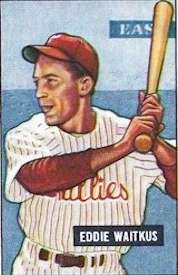Eddie Waitkus
Edward Stephen Waitkus (September 4, 1919 – September 16, 1972) was a Lithuanian American first baseman in Major League Baseball who had an 11-year career (1941, 1946–1955). He played for the Chicago Cubs and Philadelphia Phillies in the National League and for the Baltimore Orioles of the American League. He was elected to the National League All-Star team twice (1948 and 1949).
| Eddie Waitkus | |||
|---|---|---|---|
 | |||
| First baseman | |||
| Born: September 4, 1919 Cambridge, Massachusetts | |||
| Died: September 16, 1972 (aged 53) Jamaica Plain, Massachusetts | |||
| |||
| MLB debut | |||
| April 15, 1941, for the Chicago Cubs | |||
| Last MLB appearance | |||
| September 20, 1955, for the Philadelphia Phillies | |||
| MLB statistics | |||
| Batting average | .285 | ||
| Home runs | 24 | ||
| Runs batted in | 373 | ||
| Teams | |||
| Career highlights and awards | |||
Early career
Waitkus, the son of Lithuanian immigrants, grew up in Boston and attended Cambridge Rindge and Latin School and Boston College. He began his professional career in 1938 playing for the Worumbo Indians, a semi-professional team sponsored by Worumbo Woolen Mill in Lisbon Falls, Maine. As a rookie, he was known as "the natural," which gave the title to the book loosely based on his life. He saw some of the bloodier fighting of World War II with the U.S. Army in the Philippines, and was awarded four Bronze Stars. Upon his return to baseball he quickly became a star for the Chicago Cubs. He also became a popular media figure, as he was well-educated and was fluent in Lithuanian, Polish, German, and French.[1] Following the 1948 season, the Cubs traded Waitkus with Hank Borowy to the Philadelphia Phillies for Monk Dubiel and Dutch Leonard.
Shooting
Just a few years into the start of what seemed a very promising career, Ruth Ann Steinhagen, an obsessed fan, shot Waitkus at Chicago's Edgewater Beach Hotel on June 14, 1949,[2] in one of the earliest recognized cases of criminal stalking.[3]
Steinhagen had become infatuated with him when he was a Cub, but seeing him every day in-season may have kept her obsession in check. Once he was traded to the Phillies, Steinhagen's obsession grew to dangerous proportions. She checked into the hotel using the alias of a former high school classmate of his and left a note at the desk, asking him to come to her hotel room on an urgent matter.
When he arrived in her room, she shot him with a .22 caliber rifle, the bullet barely missing his heart. She immediately called the desk to report the shooting and was found cradling his head in her lap.[3] Waitkus was taken to the Illinois Masonic Hospital,[4] where he nearly died several times on the operating table before the bullet was successfully removed. Steinhagen never stood trial but instead was briefly confined to a mental institution.
Return to action
In uniform on the night of August 19, 1949, for the first time since he had been shot in Chicago, Waitkus was feted by the Phillies on "Eddie Waitkus Night" at Shibe Park and showered with gifts. Waitkus finished the season with a .306 batting average, playing in only 54 games.
Waitkus continued his resurgence in the 1950 Philadelphia Phillies season as the leadoff hitter for the Whiz Kids team that won the 1950 National League Pennant. Waitkus led the team in scoring with 102 runs.[5] Waitkus made his only post-season appearance in the 1950 World Series. After the 1950 season, Waitkus was named the Associated Press Comeback Player of the Year.[6]
Later life
Prior to the 1954 season, the Baltimore Orioles purchased Waitkus from the Philadelphia Phillies for $40,000 (equivalent to $381,000 in 2019). Released by the Orioles in 1955, he returned to the Phillies[7] for the remainder of the season. After the 1955 baseball season was complete, the Phillies released Waitkus.[8]
Waitkus taught at Ted Williams' baseball camp before dying of esophageal cancer at age 53.[9]
The Natural
Author Bernard Malamud, wove the basic elements of the Waitkus story and other baseball legends (notably that of Joe Jackson) into The Natural.[10] The book was published in 1952 and was made into a Hollywood film starring Robert Redford and Glenn Close released in 1984.
The film's DVD features a biography of Waitkus and notes that baseball writers called him "a natural" early in his career. However, Waitkus' tragedy only figures in the beginning of the story; the remainder more closely alludes to Shoeless Joe Jackson and the problem of gambling affecting the integrity of the game.
References
- Marshall, William (1999). Baseball's Pivotal Era, 1945–1951. Kentucky, USA: University Press of Kentucky. pp. 528. ISBN 9780813120416.
- "Silly Honey". Time. June 27, 1949. Retrieved July 22, 2012.
- Andrews, Dale (March 26, 2013). "Stalker". SleuthSayers.
- Associated Press, “Eddie Waitkus, Major League Player, Shot,” The San Bernardino Daily Sun, San Bernardino, California, Wednesday 15 June 1949, Volume LV, Number 247, page 1.
- https://www.baseball-reference.com/teams/PHI/1950.shtml
- "Waitkus, Who Beat Death Rap, 'Comeback King'". Ellensburg Daily Record. November 10, 1950. p. 3. Retrieved July 22, 2012.
- Phillies sign Eddie Waitkus
- Phillies release Waitkus, Lowrey; Sell Bob Kuzava
- Munich tragedy has happened before
- "This Day in Philly Sports History: A Demented Fan and the Natural". PhillySportsHistory.com. June 14, 2011. Retrieved July 22, 2012.
External links
- Career statistics and player information from MLB, or ESPN, or Baseball-Reference, or Fangraphs, or Baseball-Reference (Minors), or Retrosheet
- Jack Bales,"The Shootings of Billy Jurges and Eddie Waitkus"
- Baseball Library
- Life And Times Of Eddie Waitkus
- Eddie Waitkus at Find a Grave